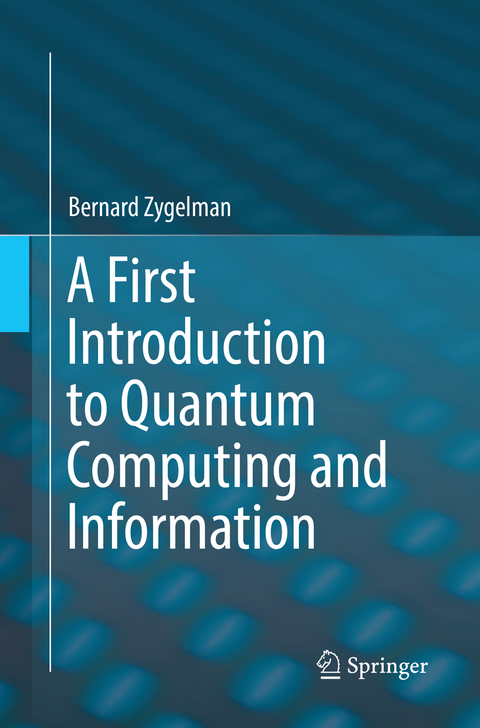
A First Introduction to Quantum Computing and Information
Springer International Publishing (Verlag)
978-3-030-06271-2 (ISBN)
This book addresses and introduces new developments in the field of Quantum Information and Computing (QIC) for a primary audience of undergraduate students.
Developments over the past few decades have spurred the need for QIC courseware at major research institutions. This book broadens the exposure of QIC science to the undergraduate market. The subject matter is introduced in such a way so that it is accessible to students with only a first-year calculus background. Greater accessibility allows a broader range of academic offerings. Courses, based on this book, could be offered in the Physics, Engineering, Math and Computer Science departments.
This textbook incorporates Mathematica-based examples into the book. In this way students are allowed a hands-on experience in which difficult abstract concepts are actualized by simulations. The students can 'turn knobs" in parameter space and explore how the system under study responds. The incorporation of symbolic manipulation software into course-ware allows a more holistic approach to the teaching of difficult concepts. Mathematica software is used here because it is easy to use and allows a fast learning curve for students who have limited experience with scientific programming.
Bernard Zygelman is a Professor of Physics at the University of Nevada, Las Vegas (UNLV). His research focuses on quantum dynamics of few-particle systems. He has been a Visiting Scientist at the Harvard-MIT Center for Ultra-Cold Atoms (CUA), the Smithsonian Astrophysical Observatory (SAO) and the Institute for Theoretical Physics (ITP) (now the Kavli-Institute) at the University of California, Santa Barbara. In the past dozen years, Dr. Zygelman has developed and taught quantum computing and information courseware at both the graduate and undergraduate level.
1 A Quantum Mechanic's Toolbox.- 2 Apples and Oranges: Matrix Representations.- 3 Circuit Model of Computation.- 4 Quantum Killer Apps: Quantum Fourier Transform and Search Algorithms.- 5 Quantum Mechanics According to Martians: Density Matrix Theory.- 6 No-Cloning Theorem, Quantum Teleportation and Spooky Correlations.- 7 Quantum Hardware I: Ion Trap qubits.- 8 Quantum Hardware II: cQED and cirQED.- 9 Errare Computatrum Est: Quiantum Error Correction.
"The book allows for people with different backgrounds to understand the building blocks of these two research fields, providing for a well-structured pedagogical basis on which both undergraduate and graduate students, lecturers and researchers from different academic backgrounds can learn the main foundations of quantum computer science. ... On its whole, the work is well organized, extensive and a relevant reference for both lecturers and researchers on quantum computation and quantum information science." (Carlos Pedro Gonçalves, zbMath 1410.81002, 2019)
“The book allows for people with different backgrounds to understand the building blocks of these two research fields, providing for a well-structured pedagogical basis on which both undergraduate and graduate students, lecturers and researchers from different academic backgrounds can learn the main foundations of quantum computer science. … On its whole, the work is well organized, extensive and a relevant reference for both lecturers and researchers on quantum computation and quantum information science.” (Carlos Pedro Gonçalves, zbMath 1410.81002, 2019)
| Erscheint lt. Verlag | 4.1.2019 |
|---|---|
| Zusatzinfo | XVII, 233 p. 41 illus. |
| Verlagsort | Cham |
| Sprache | englisch |
| Maße | 155 x 235 mm |
| Gewicht | 527 g |
| Themenwelt | Mathematik / Informatik ► Informatik ► Theorie / Studium |
| Naturwissenschaften ► Physik / Astronomie ► Quantenphysik | |
| Schlagworte | Bell's Inequality • Grover's algorithm • Quantum Computers • quantum encryption • quantum entanglement • quantum error correction • Quantum Fourier Transform • quantum mechanics • quantum parallelism • quantum teleportation • Shor's algorithm • Spooky action at a distance • The EPR Paradox |
| ISBN-10 | 3-030-06271-6 / 3030062716 |
| ISBN-13 | 978-3-030-06271-2 / 9783030062712 |
| Zustand | Neuware |
| Haben Sie eine Frage zum Produkt? |
aus dem Bereich


